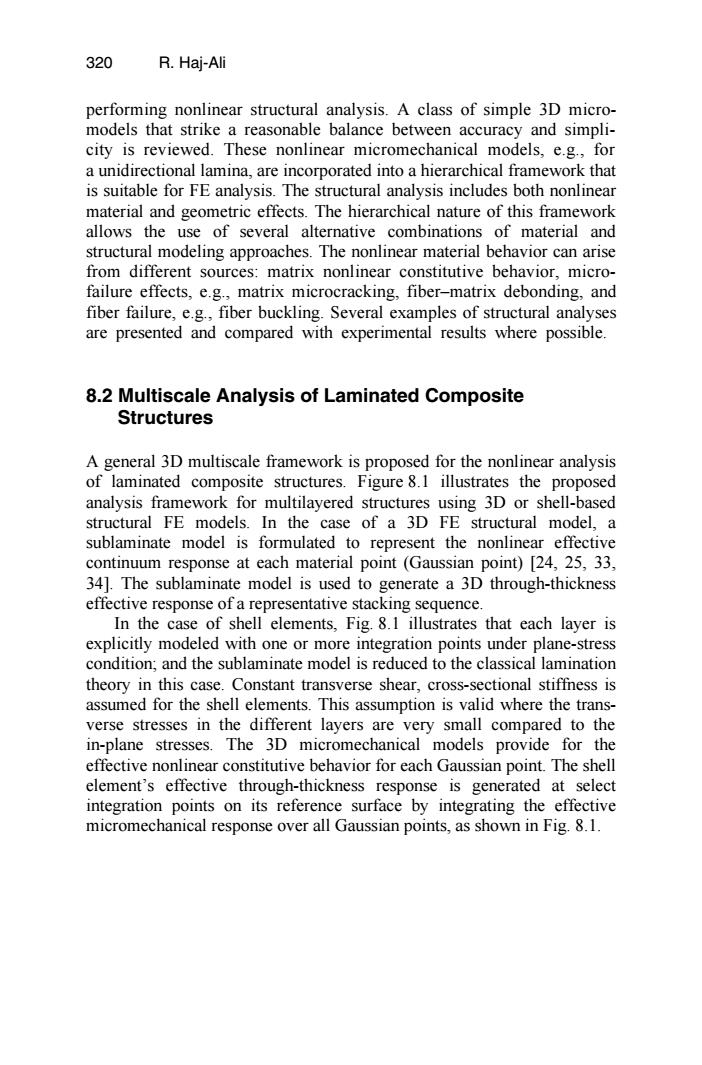正在加载图片...

320 R.Haj-Ali performing nonlinear structural analysis.A class of simple 3D micro- models that strike a reasonable balance between accuracy and simpli- city is reviewed.These nonlinear micromechanical models,e.g.,for a unidirectional lamina,are incorporated into a hierarchical framework that is suitable for FE analysis.The structural analysis includes both nonlinear material and geometric effects.The hierarchical nature of this framework allows the use of several alternative combinations of material and structural modeling approaches.The nonlinear material behavior can arise from different sources:matrix nonlinear constitutive behavior,micro- failure effects,e.g.,matrix microcracking,fiber-matrix debonding,and fiber failure,e.g.,fiber buckling.Several examples of structural analyses are presented and compared with experimental results where possible. 8.2 Multiscale Analysis of Laminated Composite Structures A general 3D multiscale framework is proposed for the nonlinear analysis of laminated composite structures.Figure 8.1 illustrates the proposed analysis framework for multilayered structures using 3D or shell-based structural FE models.In the case of a 3D FE structural model,a sublaminate model is formulated to represent the nonlinear effective continuum response at each material point(Gaussian point)[24,25,33, 34].The sublaminate model is used to generate a 3D through-thickness effective response of a representative stacking sequence. In the case of shell elements,Fig.8.1 illustrates that each layer is explicitly modeled with one or more integration points under plane-stress condition;and the sublaminate model is reduced to the classical lamination theory in this case.Constant transverse shear,cross-sectional stiffness is assumed for the shell elements.This assumption is valid where the trans- verse stresses in the different layers are very small compared to the in-plane stresses.The 3D micromechanical models provide for the effective nonlinear constitutive behavior for each Gaussian point.The shell element's effective through-thickness response is generated at select integration points on its reference surface by integrating the effective micromechanical response over all Gaussian points,as shown in Fig.8.1.a unidirectional lamina, are incorporated into a hierarchical framework that is suitable for FE analysis. The structural analysis includes both nonlinear material and geometric effects. The hierarchical nature of this framework allows the use of several alternative combinations of material and structural modeling approaches. The nonlinear material behavior can arise 8.2 Multiscale Analysis of Laminated Composite Structures A general 3D multiscale framework is proposed for the nonlinear analysis of laminated composite structures. Figure 8.1 illustrates the proposed analysis framework for multilayered structures using 3D or shell-based structural FE models. In the case of a 3D FE structural model, a sublaminate model is formulated to represent the nonlinear effective continuum response at each material point (Gaussian point) [24, 25, 33, 34]. The sublaminate model is used to generate a 3D through-thickness effective response of a representative stacking sequence. In the case of shell elements, Fig. 8.1 illustrates that each layer is explicitly modeled with one or more integration points under plane-stress condition; and the sublaminate model is reduced to the classical lamination theory in this case. Constant transverse shear, cross-sectional stiffness is in-plane stresses. The 3D micromechanical models provide for the effective nonlinear constitutive behavior for each Gaussian point. The shell element’s effective through-thickness response is generated at select integration points on its reference surface by integrating the effective micromechanical response over all Gaussian points, as shown in Fig. 8.1. R. Haj-Ali from different sources: matrix nonlinear constitutive behavior, microfailure effects, e.g., matrix microcracking, fiber–matrix debonding, and fiber failure, e.g., fiber buckling. Several examples of structural analyses are presented and compared with experimental results where possible. models that strike a reasonable balance between accuracy and simplicity is reviewed. These nonlinear micromechanical models, e.g., for performing nonlinear structural analysis. A class of simple 3D microassumed for the shell elements. This assumption is valid where the transverse stresses in the different layers are very small compared to the 320